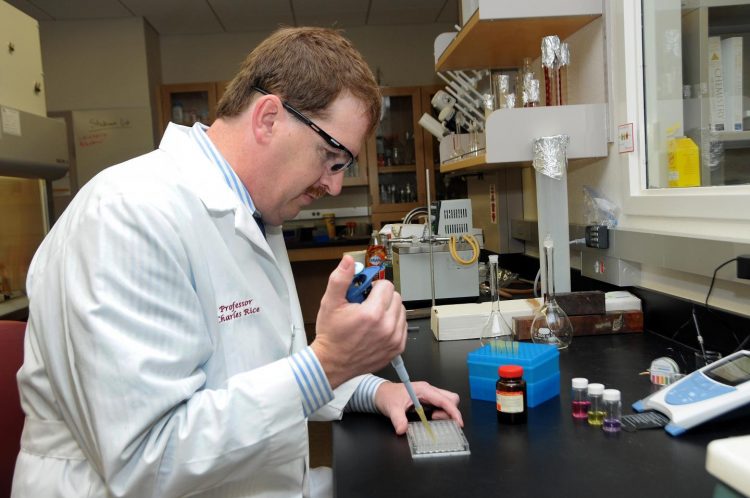OU team develops new antibiotic to fight MRSA

Rice and team have been able to invigorate older drugs from the penicillin family by combining them with BPEI. Credit: University of Oklahoma
Charles Rice, principal investigator and professor in the Department of Chemistry and Biochemistry, OU College of Arts and Sciences, with team members Robert Cichewicz and Daniel Glatzhofer, both OU chemistry professors, has been able to invigorate older drugs from the penicillin family by combining them with BPEI. While this new formulation requires FDA approval, the approach restores efficacy to obsolete antibiotics.
“The use of first-line antibiotics to kill MRSA or other infectious bacteria will improve patient outcomes and lower the economic burden,” Rice said. “The discovery in our laboratory has made it possible to create an effective antibiotic that can reduce expensive hospitalization costs.”
Leading up to the discovery, Rice was working in his laboratory when he discovered a way to neutralize the MRSA bacteria so that it is no longer resistant to methicillin. This method can be used to neutralize other infectious bacteria.
The takeaway from these experiments is that any number of penicillin-type drugs combined with BPEI or related polymers could create a new first-line drug for treating infectious diseases and change how MRSA and other infectious bacteria are treated.
The Centers for Disease Control considers MRSA a serious threat to human health. MRSA infected 80,500 people in 2011 and nearly one in seven cases resulted in death. When MRSA colonies invade host tissue, they release toxins that cause tissue injury leading to patient morbidity.
Until now, more costly and highly toxic antibiotics of last resort were used to treat MRSA. The new first-line combo drug developed at OU by Rice and his team has the potential to change how patients with MRSA are treated.
Funding for this research was provided by the National Institutes of Health and the University of Oklahoma. The Journal of Antibiotics has published a paper on the OU-developed first-line combo drug to treat deadly infectious bacteria, such as MRSA.
For more information about the development of this new combo drug, please contact Rice at rice@ou.edu. The Rice laboratory is located in the Stephenson Life Sciences Research Center on the OU Research Campus in Norman, Oklahoma.
Media Contact
All latest news from the category: Life Sciences and Chemistry
Articles and reports from the Life Sciences and chemistry area deal with applied and basic research into modern biology, chemistry and human medicine.
Valuable information can be found on a range of life sciences fields including bacteriology, biochemistry, bionics, bioinformatics, biophysics, biotechnology, genetics, geobotany, human biology, marine biology, microbiology, molecular biology, cellular biology, zoology, bioinorganic chemistry, microchemistry and environmental chemistry.
Newest articles

Properties of new materials for microchips
… can now be measured well. Reseachers of Delft University of Technology demonstrated measuring performance properties of ultrathin silicon membranes. Making ever smaller and more powerful chips requires new ultrathin…

Floating solar’s potential
… to support sustainable development by addressing climate, water, and energy goals holistically. A new study published this week in Nature Energy raises the potential for floating solar photovoltaics (FPV)…

Skyrmions move at record speeds
… a step towards the computing of the future. An international research team led by scientists from the CNRS1 has discovered that the magnetic nanobubbles2 known as skyrmions can be…





















